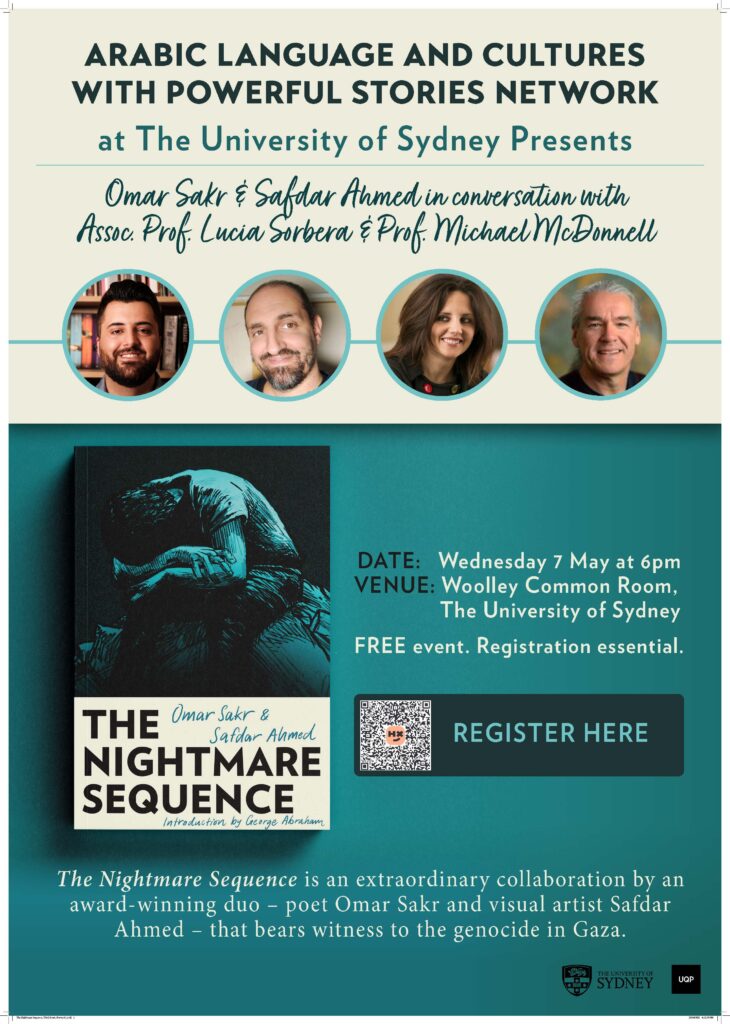
Preserving the Memory of KBHAC
I would like to acknowledge the Gadigal people of the Eora Nation, the traditional custodians of the land from which I am writing and pay my respects to the Elders both past and present. I would also like to acknowledge the Dunghutti and other First Nations peoples of this country who were victims of the Australian Government policies that created the Stolen Generations.
This semester I was given the amazing opportunity to work with Kinchela Boys Home Aboriginal Corporation (KBHAC). The aim of the project was to rework an empty office room in the KBHAC headquarters in Waterloo into an archive room and small exhibition space that would document the history of the organisation. The completion of this project would not have been possible without the support of the Uncles, Aunties and descendants who dedicate themselves to KBHAC. A further thanks goes to Jadzia Stronell who was my partner on this project.
Who are KBHAC?
KBHAC is an organisation that was created by and for the survivors of Kinchela Aboriginal Boys Training Home (KBH), a ‘home’ built on the stolen land of the Dunghutti people 20km north-east of Kempsey that housed 400-600 Aboriginal boys forcibly removed from their families by the NSW Government under an assimilation project that lasted from 1924–1970. KBHAC aims to help these men to restore their identities and lives, and to address the impacts of intergenerational trauma felt by the families and descendants of KBH survivors.
The extensive offerings of this organisation to its community, in its many services, community engagement and professional research, means that completing tasks such as developing a room to archive their founding documents ends up on the back burner. However, this organisation has emerged from such a powerful history that should never be forgotten. This mission becomes especially important when considering that KBH is severely under researched, and the information that is available to the public, and even to survivors and descendants is extremely limited. Moreover, the aging demographic of the Uncles of KBH acts as a further imperative for preserving the history of KBH and KBHAC.
You can read more about KBH and KBHAC through via the organisations website https://kinchelaboyshome.org.au/
The Project
From the early days of working on this project, Jadzia and I felt it was crucial to keep the KBHAC community at the centre of our project. In order to do this, we wanted to demonstrate our interest in the organisation by volunteering at the KBH 100th Anniversary weekend in Kempsey. The weekend featured the buttering of countless slices of bread. But also many meaningful moments such as getting to see the Uncles walk through the KBH gate and talk about how far they have come, to getting to see the younger generations playing in the yard of KBH, a place of many painful memories for their elders. This experience really highlighted the healing process that organisations such as KBHAC are so crucial in nurturing. This experience also shaped our understanding that the final project should focus on the countless achievements of KBHAC and the strength of survivors, rather than on the traumas that have been experienced by this community.
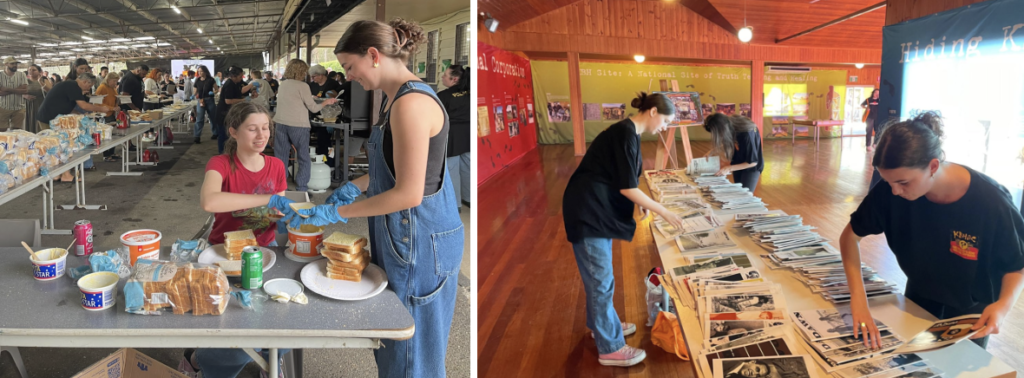
To see more photographs from the KBH 100th Anniversary, such as the uncles walking through the KBH gate, please see the KBHAC social media.
The project began with piles and piles of photographs and documents that KBHAC staff wished for us to organise into an ‘archive room’. This source material had been stored by various members of the organisation since its founding in 2002, with the documents ranging from inaugural meeting minutes to old newspaper clippings. However, the disarray of the documents meant that they were limited in their usefulness. The sorting process took place across our nine weeks working with the organisation, with the documents eventually being sorted into themes (e.g.: general events and founding). With the support of KBHAC, we were able to purchase materials for the room which included a shelf, archive boxes, folders, photo albums and display folders. The finalised archive room consisted of 15 categorised archive boxes, with 110 total subcategories. We also organised the Dawn and New Dawn Magazines into display folders with a cover page that notes the issues included in the folder and a QR code leading to the AIATSIS online repository. Finally, the photographs were sorted with the help of KBHAC staff into events and placed into photo albums.
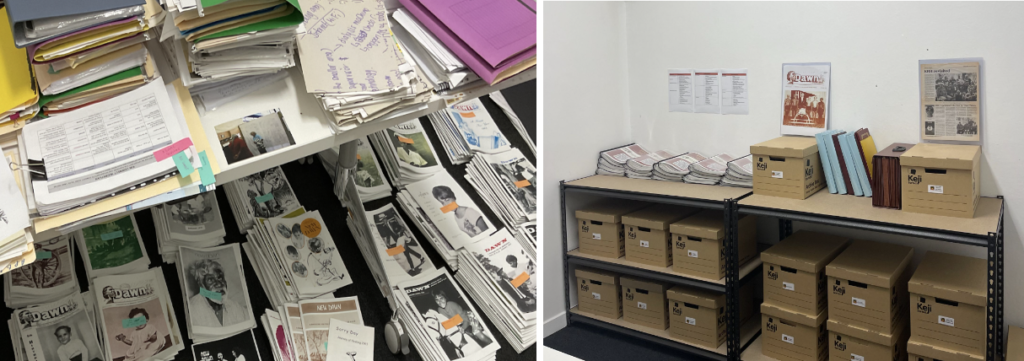
During the sorting process we identified key events in KBHAC’s history, deciding that some of these events should be displayed in the archive room at KBHAC. These events included the first meeting at Picton, Journey of Healing, Parliamentary Dinner and Koori Knockout. The images and documents that featured on this display were chosen in consultation with Aunty Leslie, Aunty Paulette, Uncle Widdy and Tiffany McComsey. It was a beautiful experience to see people who have been involved with the organisation for such a long-time reminiscing and getting excited about our project. Moreover, it became apparent that many of these documents and photographs had never been seen by the Aunties and Uncles, confirming the importance of our project. The main takeaway from this conversation was that the Aunties and Uncles were grateful we were there and showing genuine interest in their work at KBHAC, reaching the conclusion that so long as we were thoughtful in our final project, the organisation would be grateful.
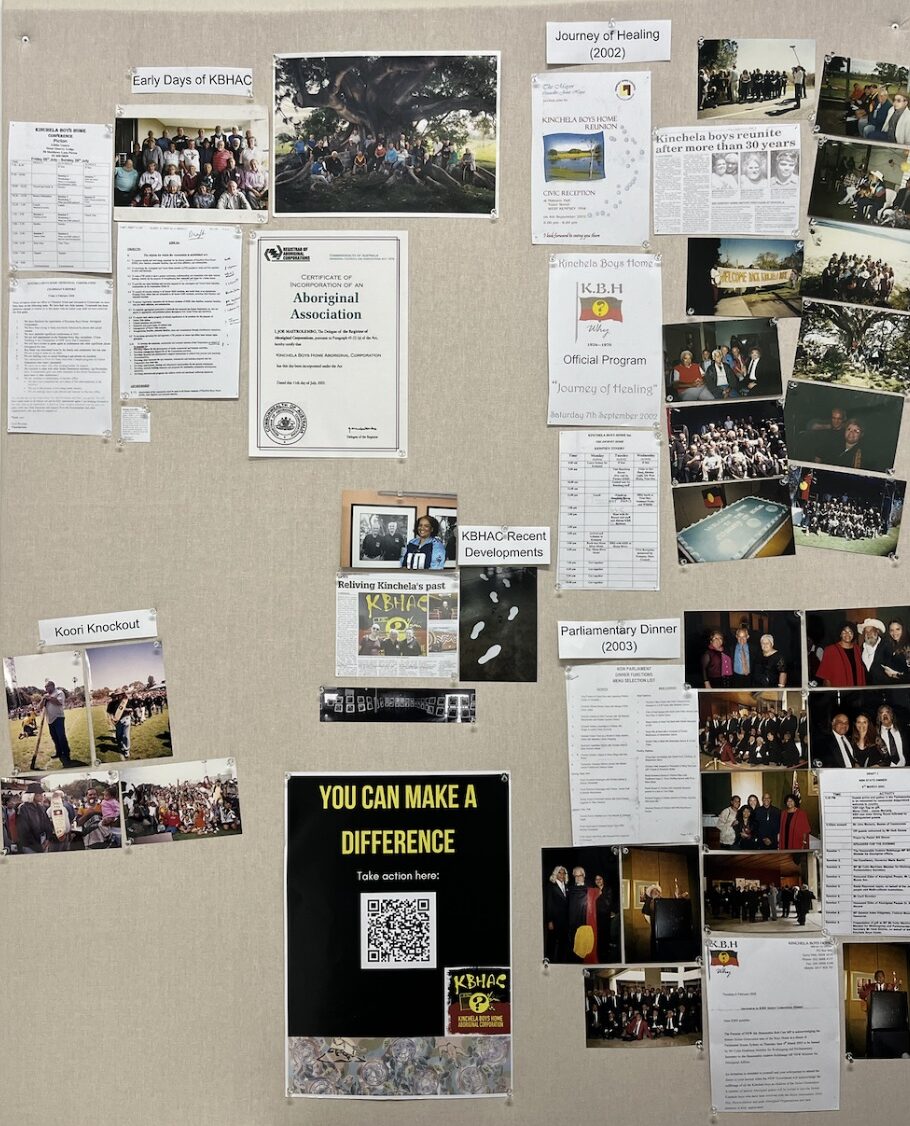
Furthermore, we acknowledged that KBH survivors and descendants are spread across Australia hence many would not frequent the KBHAC office to see the archive room. Yet, we felt it was important for those most linked to KBHAC to have access and ownership over their history. For this reason, we digitised some sources, which were selected in consultation with KBHAC staff. The time constraints of the project meant that we were only able to digitise 27 sources, which exist on a spreadsheet that displays a digitised version of the source and an approximate 100-word description. The hope is that in time these sources can be moved onto the KBHAC website and social media pages.
The work done by survivors and descendants at KBHAC is incredibly valuable and must be remembered. Believing that I had a slight role in supporting such an important organisation is an experience I will carry with me forever. Moreover, there is still much work to be done in the KBHAC office which is why Jadzia and I intend to return in the New Year. In our continued work we plan to put up a timeline of KBHAC’s establishment, continue to sort through any remaining documents, develop the exhibition space further, and aid in the publishing of digitised source material.
Preserving the Past, Inspiring the Future: A History of Riding for the Disabled, Ryde.
When I set out to create a promotional history video for the Riding for the Disabled Association (RDA) Ryde, I was faced with the unique challenge of condensing the centre’s 40-year history into a digital format that would engage and inspire a diverse audience. The project, now completed, has been a highly rewarding journey, of course it had its challenges, but these only highlighted the importance of adaptability and perseverance in public history projects.
The Vision
The inspiration for this project arose from a gap identified during my initial meetings with Ryde. While the centre’s general history had been documented in the book ‘Celebrating 50 Years of RDA NSW’, there was not an accessible digital medium that captured the essence of its four decades of service. My project aimed to address this gap by creating a video that resonated with modern audiences whilst also acting as a promotional tool to encourage greater participation and support for the centre, as it is not-for-profit and run wholly by volunteers. Therefore, I adopted a digital approach to ensure accessibility and outreach, making the history of Ryde accessible to anyone, anywhere. By creating a video intended to be broadcasted across YouTube, social media platforms and the RDA’s website, my project leveraged technology to bring RDA Ryde’s history to life for current and future generations.
The Process
Bringing the project together required an intertwining of research, adaptability, and community engagement. This included:
- Extensive Research:
– Photographic Archives: Sorting through decades of photographs presented both an opportunity and a challenge. Some of the images were undated and not organised chronologically, but they became invaluable in illustrating milestones such as events, riders, and the contributions of long-term volunteers.
– Oral Histories: Interviews with long-standing volunteers added depth and authenticity to the narrative. Selecting key moments from hours of footage was a meticulous process but ultimately introduced elements of emotional resonance to the final project.
– Firsthand Observations: volunteering weekly provided me with invaluable insights into the RDA’s present-day operations and mission, enriching the historical narrative with contemporary context.
– Secondary Resources: Books like ‘The Spirit of RDA’ and ‘Celebrating 50 Years of RDA NSW’ ensured the accuracy of key dates and events.
2. Community Collaboration:
– Engaging with the RDA community was central to the project’s success. The enthusiasm of long-standing volunteers demonstrated the importance of preserving the centre’s legacy.
Themes and Messages
The video is structured around key themes that highlight the RDA’s enduring values and impact:
- Community Resilience: Showcasing how volunteers and the local community have sustained the RDA through challenges, including the relocation of the centre.
- Inclusivity and Empowerment: Emphasising the transformative power of equine therapy for individuals with disabilities.
- Legacy and Progress: Bridging the past and present to underscore the continuity of the RDA’s mission.
- Volunteerism: Celebrating the volunteers who form the backbone of the organisation.
- Key Riders: Highlighting inspirational figures like Paralympian Jan Pike to demonstrate the profound impact of the RDA’s work.
Impact
The completed video serves multiple purposes:
– Preservation: It documents and celebrates the RDA Ryde’s history, ensuring that its legacy is not forgotten.
– Promotion: As a digital resource, the video is a tool for attracting new volunteers, donors, and participants.
– Inspiration: By sharing the stories of resilience, empowerment, and community spirit, the video inspires deeper appreciation of the RDA’s work and greater involvement from a wide audience.
The project has also laid the groundwork for future initiatives, providing a comprehensive history of the Ryde centre for future volunteers, and a model for other RDA branches to document their histories in engaging and accessible ways.
Personal Reflection
Working with the RDA Ryde has been a profoundly enriching and rewarding experience. Witnessing the beaming smiles of riders as they arrive every week is a testament to the organisation’s impact. I am deeply grateful to the RDA for allowing me to contribute to their mission and I look forward to continuing my volunteer work with them in the future.
Looking Ahead
This project is not just a celebration of the past but a step toward ensuring the RDA’s future. The involvement of long-term volunteers proved fundamental in adding depth to the project and formed the heartbeat of the video. By making the centre’s history accessible and engaging, it paves the way for greater community involvement and sustained support. I hope this video inspires others to explore and share the stories of other community organisations for the generations to come.
* (video will be attached when officially approved by RDA NSW.) *
Turn Up Your Radio: An Oral History of fbi radio

This semester, I was privileged enough to work with fbi radio on an incredible oral history of their music library. Established in 1995, and having broadcast full time since 2003, fbi is a community radio station in Eora, Sydney. Driven by a policy to play 50% Australian music, with half of that from Sydney, fbi is a radically inclusive organisation that celebrates the diversity of our local music scene. My project ‘Turn Up Your Radio’, presented on fbi’s website as a multi-media piece, intersperses oral histories with text, photo, and video to reflect upon various chapters in fbi’s history. Oriented towards fbi’s existing listenership, my project is an affirmation of the importance of community radio as the fabric of local culture, arguing for the need of institutions such as fbi to pioneer subaltern voices and experiences.
Conceiving the project in the first place was a creative challenge in meeting fbi’s need for a compelling piece that showcased the diversity of the organisation whilst also producing something within their existing content model. In working with fbi’s team, we decided to hone in on fbi’s library of over 20,000 CDs. In this library, next to the top dance release of 2014, is a demo by an office worker in a pub-rock band that only ever recorded one single. Next to that is a collection of ambient beats made by a student in their bedroom, besides the blues singer that has been gracing Sydney stages for decades.
However, due to the sheer size of the library, I needed a throughline. Even if I carefully went through each CD in the library, being able to grasp its historical significance was impossible within the remits of this project. I needed a creative solution that would make it possible for me to comprehend the library while also connecting with fbi’s vision. Oral histories were the perfect solution. Just as oral histories have historically been used to amplify the voices often neglected in written history, oral history in this project sought to shine a spotlight upon the incredible people who have supported Sydney’s music scene. Recorded in fbi’s studio using the audio-processing software ‘Reaper’, oral histories were perfect for the project as it coordinated with fbi’s identity as a radio station and gave me a way to work collaboratively with fbi volunteers and staff past and present.
My final project features oral histories from from Stuart Coupe, presenter of Wild Card from 2003-present, Stephen Goodhew, music director from 2013-1017, Dan Zilber, music director from 2003-2017, Simon Caldwell, DJ and longtime presenter of Monday Sunset, Cassandra Wilkinson, president of fbi from 1997-2021, Lee Tran Lam, writer and presenter of Local Fidelity from 2007-2023, Caroline Gates, programming director from 2010-2017 and John Ernest Dinamarca, volunteer and project manager of fbi’s social outreach program from 2015-17. Meeting with these incredible, was not only incredibly enlightening from an intellectual perspective, by personally rewarding in hearing the stories of this incredible organisation and the impact they have had on it.
As the first extended historical work done for fbi, this is a significant step in celebrating this incredible organisation, its originality lying in both its novelty, but also synthesis of modalities relevant to the station. As I spoke to many interviewees, they commented on the need for fbi to have a history written about them and how personally beneficial it was for them to reflect upon their time at the station, which has irrevocably transformed their life’s trajectory. I hope that this project, publicly available on the fbi website, will impact fbi by elevating the awareness of the organisation’s historical significance and the need for its story to be officially recorded. My project has told stories about fbi that have otherwise never been publicly recorded and I hope it inspires future historical work about the station. As Stuart Coupe beautifully put it in our interview, “[the] library is a remarkable piece of Music history. We talk about tombs in Egypt and artefacts being buried, and hopefully that library stays together.”
While my article has not yet been published, I have included two oral histories below to check out!
Day One: fbi 94.5 Present: Kill Your Idols (2003)
August 29, 2003. Since 1995, FBi (Free Broadcast Inc) Radio 94.5FM had been broadcast on special occasions from an empty shop next to the Clock Hotel in Surry Hills, on milk crates in a caravan in Bondi Beach or above a suckling pig restaurant on George Street. However, after over six years of lobbying and fundraising, the fbi Idols, constituting Sarah Blasko, Dave McCormack, Spod, Tony Buchen, Upshot, and Front-End Loader performed to a packed foyer at the fbi headquarters. Their live cover of ‘Turn Up Your Radio; by the Master’s Apprentices was the first song to be broadcast on air and was immortalised on the ‘FBI 94.5FM Presents: Kill Your Idols” a compilation of 21 songs (many of which were only demos), that encapsulated the Sydney scene at the time. Check out some footage from the day, alongside Music Director (2003-2017), Dan Zilber’s account of the day and the compilation CD that came out of it, Kill Your Idols.
Discovering New Talent: Harley, Harley (2011)
At the core of fbi’s mission to play 50% Australian music, is their commitment to amplifying grassroots talent that may be otherwise neglected by commercial; radio or major labels. For example, Music Open Day saw flocks of artists coming into the station hand-delivering demos on burnt CDs, keen for their first radio play. Some of these CDs had cover art, some in an entirely plain packaging straight from Officeworks. Others simply wrapped up their demo in the ripped-out pages of a medical textbook and in the case of Rainbow Chan, brought in her demo in a hand sewn and embroidered fabric sleeve. From a father with a newborn handing in a demo to the station – who later turned out to be a member of rock band and fbi success-story Wolf Mother – or music director Stephen Goodhew being live serenaded in his office, Music Open Day encouraged everyone and anyone to come in and take a shot. With the commitment of presenters, volunteers, and staff to scour the city for new releases, fbi has been responsible for the first radio plays of some of the biggest Australian exports from The Kid Laroi and Julia Jacklin, to 1300 and Nina Las Vegas, and countless invaluable independent artists. One notable story is of a 15-year-old Flume who handed in his first demo under the name ‘Harley’ to the station in 2007.
The Sydney Convicts Archive: What is a Rugger Bugger?

This semester I was privileged enough to work with the Sydney Convicts RUFC for my HYST3902 project, composing an archive and a short written history for the institution. Initially a daunting task, I somehow managed to pull through and deliver an archive with over 170 entries, ranging from simple scans of two-decade old posters to digitisations of 60+ page booklets.
The Point
The originality and argument of this project lies in its subject matter, the Sydney Convicts, acting both as a documentation of their now 20-year history and furthering the argument that they made with their founding in 2004. The originality of the project is by contributing to the history of rugby by applying serious historical attention to the Sydney Convicts as a gay rugby club adds another dimension to their agenda to combat both stereotypes of gay men, and the deep-rooted homophobia in rugby as a sport. As the Star Observer reported in 2004, “They see themselves as a rugby team first and foremost, which just happens to be gay.” By documenting the history of the Convicts like one would the history of any other amateur rugby club, the novelty of the Sydney Convicts in contemporary rugby is extended into the history of rugby. The argument of the project is then that it ‘historicizes’ the convicts, both within the history of rugby and establishes a singular historical narrative of the club itself. According to Joan Scott, “The point of new historical investigation is to disrupt the notion of fixity, to discover the nature of the debate or repression that leads to the appearance of timeless permanence.” This framework of ‘historicization’ disrupts the ‘permanence’ of the rugby landscape, wherein clubs have existed for well over a century even on the amateur level, by paying serious historical attention to a relatively young club in the Convicts. This is evident in account of the Convict’s early years, where many of the players had been excluded from their previous teams for their sexualities and the formation of a club that accepted these players was met with hostility from several other clubs in the Sydney suburban championship. By showing that the Sydney amateur rugby landscape, despite having some clubs that date back over 100 years such as the Manly Savers, has changed with the inclusion and eventual acceptance of the Convicts, amateur rugby is integrated into the greater social and historical processes of the society it exists in. Therefore, by paying serious historical attention to the Sydney Convicts, the project has both an original premise in documenting the relatively new club, and that documentation makes an argument by ‘historicizing’ the club and rugby as subject to both social and historical conditions.
What is a Rugger Bugger?
One particularly well documented part of the club’s history was the annual-ish ‘Rugger Bugger’ with cards, posters and news reports about the event preserved.
The Rugger Bugger, starting in 2004, is a show periodically held by the Convicts as a fundraiser to finance the club and travel to international events the convicts attend, most notably the bi-annual Bingham Cup.
The first several shows were held at the Midnight Shift, a historical LGBT club in Sydney, which has since closed down and been reopened as ‘Universal’ by a new set of owners. As such these cards are not only a piece of Convict history, but also of Sydney’s pre-lockout laws nightlife.
Wakulda Archive and Digital Interpretation Project: Interwoven Stories
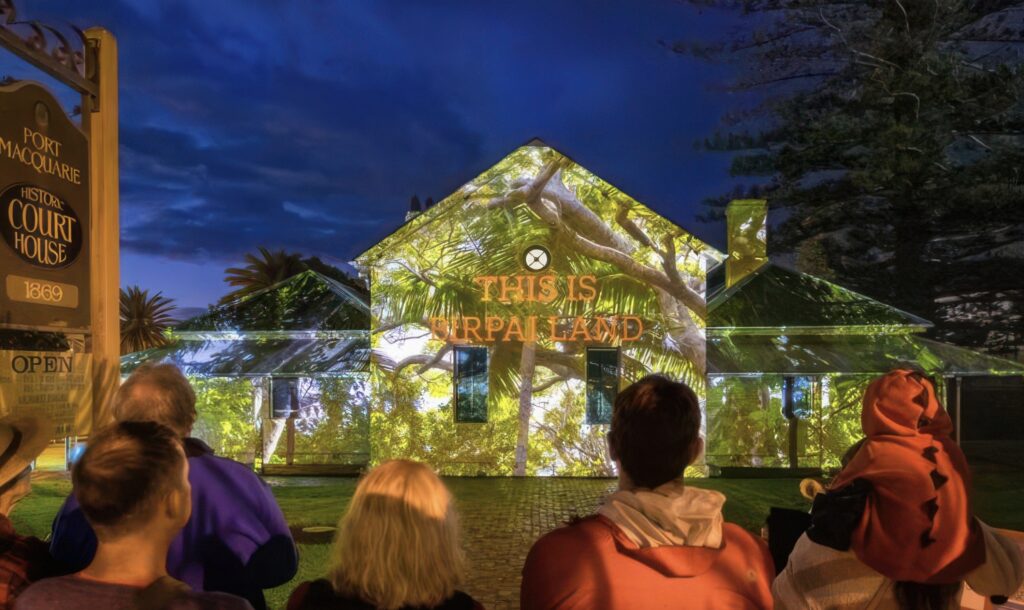
This semester I worked with Studio ESEM https://www.studioesem.com/ to organise the digital sources from one of their past projects in an archive and present it in a new non-linear digital format.
The project is based on Studio ESEM’s 2021 video projection installation Wakulda (Weaving our Stories As One), https://www.studioesem.com/projects/wakulda which marked the 200th anniversary of the British settlement of Port Macquarie, by reflecting on Indigenous/Birpai perspectives on this history.
The digital interpretation element of my project presents the sources that Studio ESEM collected during the production of Wakulda in a new non-linear digital format. My creative approach and presentation of the sources will enable the audience to engage with these stories in a new way. In the new format I was able to further explore and develop narrative threads from the original project such as Indigenous/Birpai perspectives on and connection to their Country, the history and impact of conservation movements in the Port Macquarie-Hastings area
My project, like the original Wakulda project focuses on the perspectives of the First Nations community of Port Macquarie, particularly the local Birpai people. The original project was significant in focusing on First Nations perspectives on a colonial anniversary, and making their voices heard in the (literal) center of the town in Port Macquarie, projected for the whole community on the Old Courthouse Building. The centering of these perspectives and personal experiences which have historically been excluded from public histories implicitly makes the argument that these are perspectives that must be listened to to gain a proper understanding of Australia’s past and to address the present day inequalities that are the effects of colonization in Australia. The project also highlights the significance of historic conservation movements in Port Macquarie and the women who lead them, a history which the original Wakulda project shone a light on, but which had historically not been well known to the Port Macquarie community, and my project also argues that this is an important history to recognize.

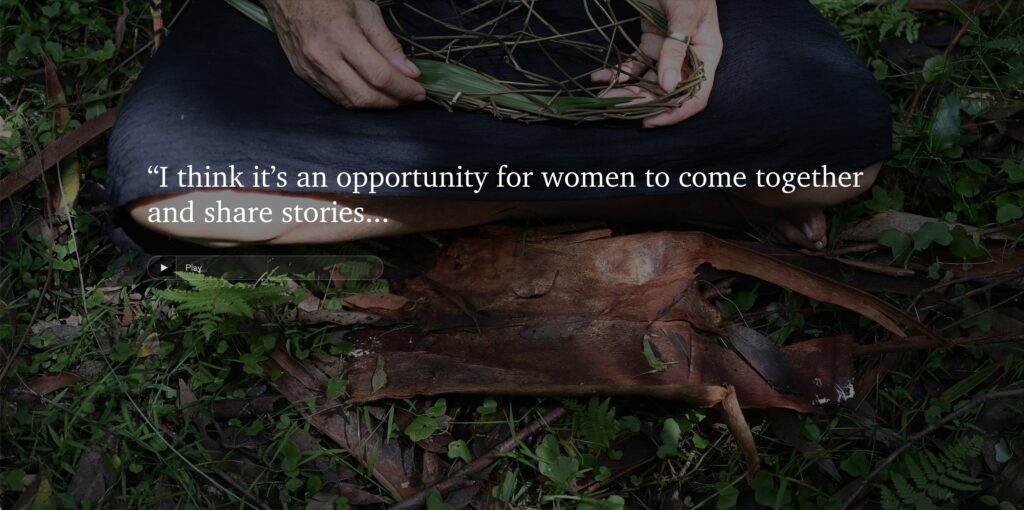
I worked with the sources that Studio ESEM collected during the production of Wakulda, which were all in digital form on a drive. This included images of historical documents and artworks; audio recordings of personal oral histories; interviews with local historians; location video and photography of Port Macquarie and the natural environment around it; photos of individuals who were interviewed; photos and videos of local community activities such as a weaving workshop and choir performance; and historical photographs. I focused particularly on the oral histories and interviews, as these were not fully captured in the original video projection, and they reveal important perspectives and insights about Port Macquarie’s history. In the digital presentation, I supplemented these with images and video to contextualise them.
In the process of cataloguing the sources, I gained a thorough understanding of this archive and found particular themes in common throughout the sources. The three key themes of my project are embodied by the sections of my digital presentation. The first was Birpai Country: Weaving Community, which focused on the local Indigenous community, members of the Birpai nations and other nations and their connection to Country. It explored the meaning of the place to them, on one hand the physical space and natural environment, and on the other, the community and people. The second theme was Conservation in Port Macquarie: A Vital Legacy, where I focused on the contributions of local woman Grace Easterbrook to protecting the natural environment and the legacy of the Port Macquarie Conservation Society. Finally, Injustices, the past, and making a better future, focused on the injustices of colonization, the historical and current day impacts on Indigenous Australians, and the efforts members of the Port Macquarie Indigenous community to create a better world for future generations.
This project will give a platform for the voices of the local Indigenous community of Port Macquarie, highlighting their perspectives. These perspectives need to be amplified and listened to for both historians and the general public to gain a proper understanding of Australia’s past: as many of the interview participants mention, truth-telling is key aspect of achieving progress. Hopefully this project will make this history more accessible to the general public through an engaging digital format, not only for the residents of Port Macquarie, but anyone who wants to gain a better understanding of Indigenous Australian history and experiences.
In the production of the original Wakulda project, Studio ESEM were focused on producing the final product and had not organized the sources they had collected. The sources still had much value to explore, as much of the sources collected had not been included in the video projection, given the 10 minute runtime. The video is still being projected in Port Macquarie, but will end projection next year, so Studio ESEM is looking to long term and continuing projects in Port Macquarie: they have continued to collaborate with Aunty Rhonda Radley, who was significantly involved in Wakulda, on various other projects.
Firstly, my spreadsheet organizes the sources into a usable archive that can be used to make the use of them in any future projects easier and ultimately help make these sources accessible to the public
Secondly my “scrollytelling” presentation of the sources, explores a new way of presenting the sources, further develops narratives from the original Wakulda project and provides a basis for Studio ESEM to explore this new format, which they are keen on building on.
The documentation of sources in the spreadsheet did not require much creativity as it followed a model that Studio ESEM had used previously. For the “scrollytelling” page Studio ESEM wanted me to explore ways of presenting the sources digitally, but there was plenty of scope for what kind of digital presentation, techniques and the themes that I drew out of the sources. I used the format of a “scrollytelling” website, which allowed me to explore the full depth of the audio and visual digital sources I was working with. The connection of the audience with the individuals who were featured was made much more concrete by including audio clips of their responses, along with transcriptions The scrollytelling pages will eventually be published on a website, and made accessible to the general public. All the audio sources are also provided in text form, which helps accessibility. Through this project, Studio ESEM wanted me to explore digital presentation of stories and histories of the Indigenous Australian community of Port Macquarie, and what this format could offer. This is part of a larger project they are working on to platform these narratives and perspectives in a digital format. They want to further develop the work I did with me (which I am keen to do) and incorporate it as part of this larger project
Public History Final Designs: “They Answered Their Country’s Call”
For my HSTY3811 project this semester, I worked with the City of Canada Bay Museum, making a series of posters and a pamphlet for their “They Answered Their Country’s Call” collection. This consists of over 1600 biographies of local WWI veterans, and the museum wanted a way to share the collection with the public in an accessible and interesting format. The 1.4mx0.8m posters are of four people, one for each poster. It features a picture of the person, linking the local history to a visual that people can relate to. The poster also has information on how to learn more about the collection. I received full creative control over these posters, something I’m incredibly grateful for. However, I did my very best at each stage to ask and implement feedback from the volunteer staff, as this is as much their project as it is mine.
This is something that supports the local community. The museum, their main reasoning behind the collection was to have an ongoing archive of local WWI veterans. This means that not only do the posters relate to local people’s own relatives, but if someone wanted to add their own relative to the collection, they could do so. Each poster has a QR code that links to a website about the collection. Whilst the website needs to be refined and a few more conversations need to be had between relevant organisations, it will hopefully result in a website with some further access to the collection and a way to contact the museum to contribute a person’s own relatives. The posters will be placed in 4 locations, rotating between to switch up the person featured. They were created in a standard format as well, meaning if more posters were to be made, they would be added to the existing group of posters. Whilst this has not happened yet, since the posters and pamphlets have not been made, this is the hope for the project.
The general theme of the posters is a vintage but colourful style. There is a paper-like texture to the posters, adding a more ‘authentic’ feel. Each person has a different background, representing where they served, e.g. Army = green background. This is a nice tie into the people’s positions and the ways they served in WWI. The other colours were chosen because they stand out from their respective backgrounds. Yellow and red were used in three of the posters, representing the poppies and the gold medals some received for their service. Blue was used in the fourth poster to represent the Australian flag and the seas travelled by these people. Each poster includes where the person served and also how they are linked to their local community. The names of each person are on a ribbon banner, similar to banners used in local honour boards. The fonts chosen can be seen as a modern twist on older poster fonts.
The pamphlet has a summary of the lives of each of the four people, giving more in-depth information about their personal lives and service to their country. It also lets people know that they can add to the collection if they wish. The pamphlet also includes the QR code and 4 locations featured on the posters. Additionally, it has a set of contact information specific to the City of Canada Bay Museum and Heritage Society, some of the people who are now in charge of the project. These pamphlets will be kept near the posters if people want more information but also can be brought to other locations where the posters aren’t being featured. This gives the project a larger reach since the City of Canada Bay is a large area.
Finally, as a volunteer at the Museum, I also helped contribute to their monthly newsletter, Nurungi. This is released both online and in hard copies and is distributed to members signed up with their email addresses. I helped to edit and find sources for one September article written by the previous secretary, who had been working in the City of Canada Bay Heritage Society for over 50 years. The article was on the history of fireplace tools, such as tongs and pokers. This is because the museum does have a set of tools that joined the collection. Each month, articles are based on either new items or displays that the museum has made, or relevant events and anniversaries – for example, for October, the museum had an article on Halloween’s history and presence in the local community.
Throughout this process, I had weekly in-person meetings with the museum staff and assisted in other ways. This was to build a connection with the local community since most staff members come from the area. Whilst these people are all volunteers, they were incredibly dedicated to their work and ensuring that this project progressed regularly. These meetings were also to get details on what needed to be on the posters and pamphlet and to get feedback on the progress, aesthetics and elements of the posters and pamphlet. The feedback, advice and relevant details were incredibly beneficial to create a final design that was suitable for the wider community, especially older members of the community. Since I happen to be a younger person, my design and technology skills were more appropriate compared to the museum staff. However, their expertise on what stood out to them in my designs was greatly appreciated, as it sometimes ended up quite different to what I thought was visually better.
Overall, I’m very proud of what I’ve managed to create for this semester-long project. The final designs have been through many changes and we have collectively come to the best design and format. In future, a project like this would benefit from seeing how effective this collection turns out to be, possibly through questionnaires or surveys about the collection. I will be in communication with the museum beyond this semester, not only to assist with making these posters and pamphlets a reality but also because I enjoyed volunteering with them.
A Collaborative Sewing Project with Aussie Hero Quilts (and Laundry Bags)
This project was not only academic; it was deeply personal. As a Royal Australian Navy (RAN) veteran, collaborating with Jan-Maree Ball OAM and everyone at Aussie Hero Quilts (and Laundry Bags) on this initiative was an honour and a privilege. I recognised this organisation’s significant impact on the Australian Defence Force (ADF) community. The heart of this organisation lies in its people—the volunteers who dedicate countless hours to crafting these quilts and laundry bags, the recipients who cherish them, and the broader Defence community that understands their importance. The impact these quilts and laundry bags have on the ADF community cannot be overstated. For someone receiving an AHQ quilt or laundry bag, it represents more than just fabric; it is a piece of home and a reminder that someone cares. The website states, “Our quilts are not works of art, but works of the heart.” This sentiment was echoed multiple times during the volunteer weekend in Canberra, which I was fortunate to attend.
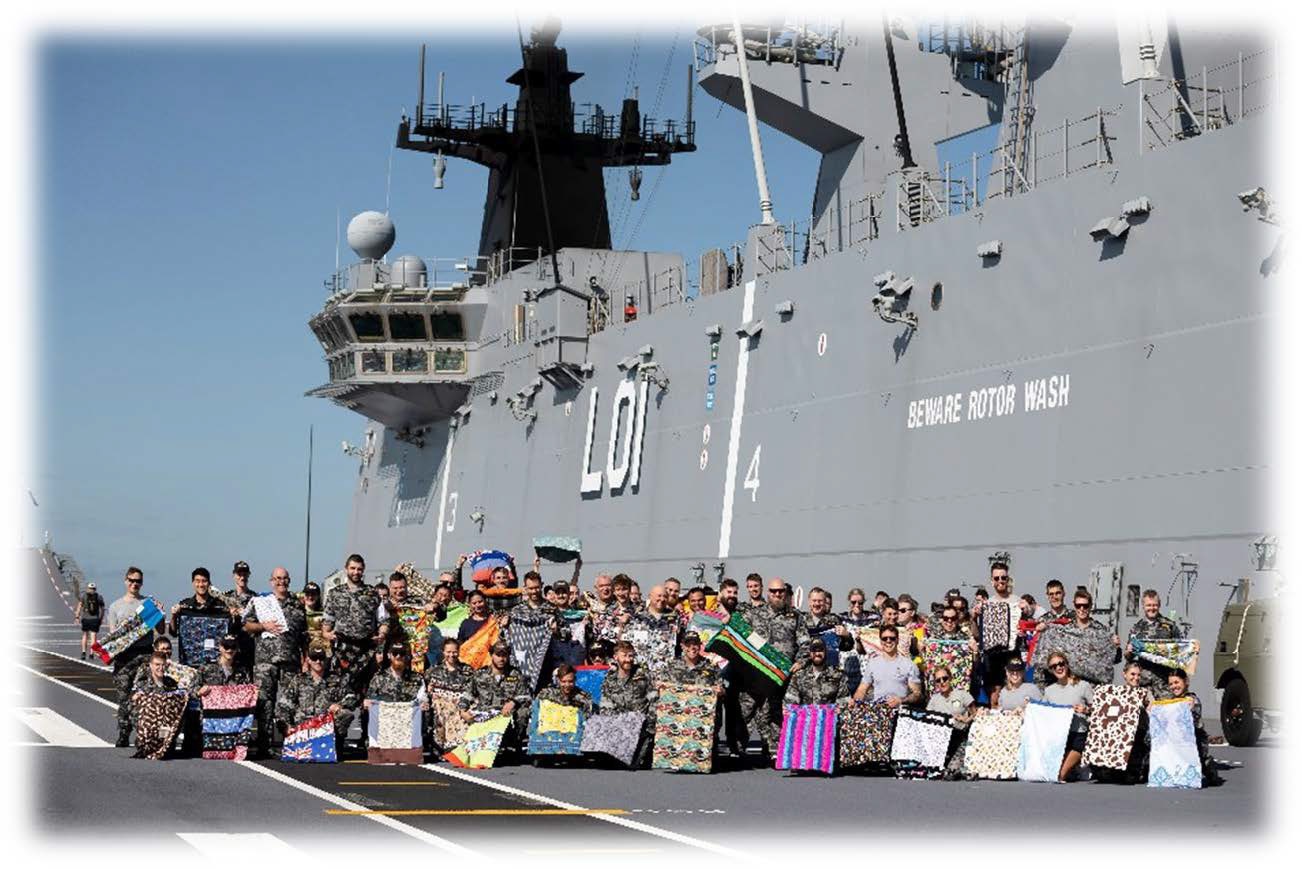
I created an online site to facilitate charity auctions and fundraising efforts in Canberra, but unfortunately, connection issues prevented its use. However, in true military fashion, we adapted and overcame the issues, reverting to the original method and successfully raising funds for this fantastic charity. This adaptability and resilience are a testament to the spirit of AHQ and the community it represents.
There was a creative transformation regarding the final project at the volunteer event, alongside the technical challenges. Initially designed as an interactive history and fundraising website, the project shifted due to privacy concerns, evolving into a more ethical and adaptable design. We are now integrating dynamic visualisations using Google Looker Studio into the existing website, featuring stunning maps and visuals highlighting where the quilts and laundry bags have travelled and the number of lives they have touched. Bringing this story to life requires technical learning and a deep emotional investment. Utilising tools like Python and Excel, the data is cleaned, sorted, and merged into a master dataset. This process was not just about crunching numbers; it was an act of preservation, piecing together the scale and reach of the charity’s work to demonstrate its profound impact.
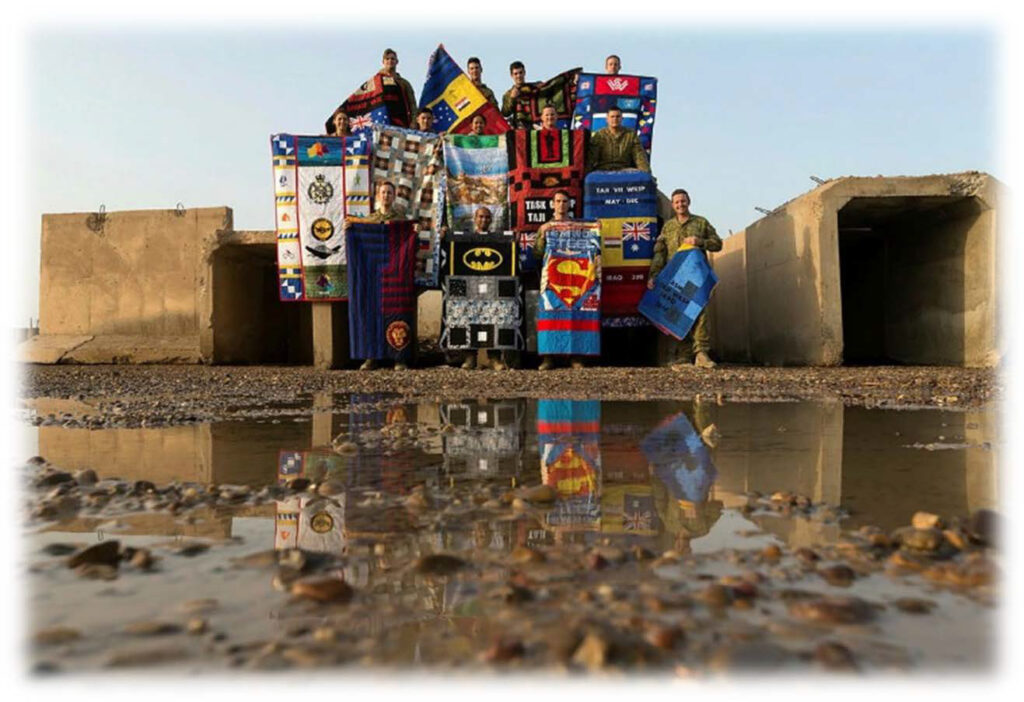
The AHQ project is not just about preserving history and inspiring the future. It showcases the intersection of public history, emotional storytelling, and technology to create something lasting and meaningful. It stands as a testament to the power of connection—between communities, generations, and even across continents. This project ensures that the story of AHQ will continue to warm hearts, just like the quilts themselves. Through innovation, dedication, and adaptability, ready to inspire anyone who believes that small acts of kindness can ripple into something extraordinary.
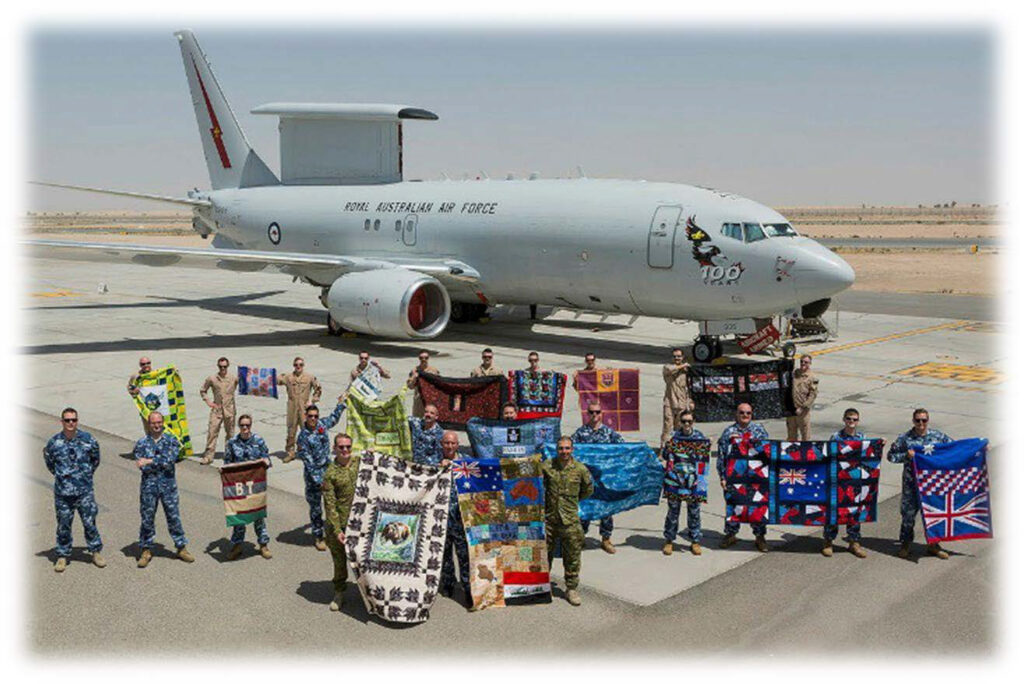
Women Cinema Pioneers: Oral Histories of Community Experience
In collaboration with members from The Society of Australian Cinema Pioneers, I have formed a webpage which outlines the available history of women members since they were granted membership in 1989. Featuring oral history interviews with Sue Milliken AO and Kerry Westwood, as well as reflections by the First Female National President Wendy Paterson, the webpage illuminates the personal experiences and professional contributions of women members across various professional sectors of the Australian Motion Picture Industry to the operation of society. In doing so, reflections on the importance of women pioneers and their history in the community are formed, highlighting the changes which have allowed a more progressive and equitable community for women – one which vastly contradicts the original patriarchal image of the society upon formation in 1933.
The oral history approach was inspired by a seemingly lack of historical documentation, especially regarding the personal interactions and community bonds which are so appealing for members. When discussing the history of women pioneers with female members, a common response was how there had been little mention of or reflection upon the extended period of operation – 56 years – where women were excluded from membership. Throughout the project, I often found myself returning to this observation. How could something so substantial seem so trivial? In further discussions, I realised the lack of personal and collective reflection on this history was likely informed by the prevailing sense of equality within the community. As Sue observed, there has always been a “genderless” feeling amongst the pioneers. My motives were then transformed from critically examining the history of women. Instead, I moved towards insighting reflections as a way of instigating greater appreciation of the contributions of both themselves and the women members before them, forming an image of the operational changes which informed the progressive and equitable community the society has increasingly become since 1989.
As previously mentioned, I feel the reflection upon the history of women members will be beneficial for the entire community. In my conversations with members, I heard there are currently discussions of redirecting attention towards the need of documenting and archiving historic materials, something which has long been missing because of the fractured locations of branches and operation of the society being entirely volunteer led. I hope the project may have a short term impact of instigating further reflection on the need for the documentation of oral histories, especially for women but also other members, while perhaps showcasing the possible routes which could be taken for forming an online database with available records of oral history interviews and other historical sources in an accessible way for the community.

Throughout the semester, I have pushed myself out of my normal comfort zone with conducting oral history interviews and discussions with people from all areas of the Society of Australian Cinema Pioneers. These past few months have been incredibly rewarding personally, and experiencing the importance of community connection and appreciation amongst professionals across the Australian Motion Picture Industry has heightened my appreciation of local organisations whose volunteers dedicate their own time for the benefits of others – and perhaps my own aspirations of becoming a part of the film industry may find myself becoming a member of the community as well one day.
Uncover the history of women pioneers and hear their oral histories here.
Marrickville Legal Centre – 45th Anniversary Project
Project Link: https://www.youtube.com/watch?v=O7KB-S-_Tpo
Originality: The project we’ve done focuses on the people who have been helped by MLC. And we focused on helping the organization refocus on the people they’ve helped, and we helped create a 20-minute video for them to mark MLC’s 45th anniversary. Because they needed a memorial video for their gala, we interviewed people who had been helped by MLC and made a video of those interviews for them to use.
Argument: Our main argument is that the MLC is a very meaningful organization, and they do fight for social justice. Many people, especially migrants, have been helped by MLC and have been able to settle in Australia. This is the point that we were trying to prove before we did this project. Therefore, our subsequent evidence and interviews with our interviewers are trying to prove that these people were indeed helped by MLC. And it turns out we proved our point. The MLC is indeed a legal center fighting for social justice, and those who have sought the help of the MLC have not only successfully defended their rights and interests with the help of the MLC, but also some of the people who have been helped by the MLC have now begun to devote themselves to helping people in their own countries better integrate into the cultural melting pot of Australia. In other words, with the help of the MLC, they are now also fighting for social justice.
Evidence: Since we completed an oral history in the form of video, the evidence we used was mainly the oral history of the interviewers. In order to prove our point, the questions we asked our interviewers were mainly about how they knew about MLC and how they received help from MLC. In addition to the historical section, we also asked the respondents how they felt when they received help from MLC. While this may not sound rigorous, we believe that emotions are a part of history, especially when we are dealing with people who once needed legal assistance. Because when people are desperate and overwhelmed, and the joy of being helped can affect people’s memories and compose new memories for them. Therefore people’s emotions are part of the equation. Of course, in addition to the interview content of the interviewees as evidence, we also read the MLC annual report and some news and newspaper content to help prove our views, so as to ensure that our research is effective and scientific.

Themes: The theme we want to develop in this project is the history of the people, especially the history of immigration in Australia. First, because the organization’s previous historical projects have focused on the organization itself, we believe that the right to tell history should be returned to the hands of the people. Especially since I’m a Marxist. My view of history is that people are the one who produce history. And interviewing people who have been helped makes MLC more aware of the importance of its work. This theme can be extended to our argument that MLC does indeed help immigrants.
Need: I think our project can not only help this organization to improve its own history. It also gives those who have been helped the opportunity to tell their own history, so that more people can learn about their immigration history. And it can also attract more immigrants to seek legal support, because many immigrants can’t get regular legal support because they don’t know where to get it. And our video can serve as a good publicity function. In this way, MLC can help more people.
Significance: As mentioned above, the significance of our work is to make people more aware of the stories of migrants and to put the power to tell them back in the hands of the people. And people can better understand that the work done by MLC is full of meaning, which can be a good way to get more people to join the legal service. This would create a positive cycle, with not only more migrants seeking help but also more volunteers joining the fight for social justice. Therefore, our project not only completed an oral history recording task, but also carried out a good publicity for MLC. Because a person may not believe what an organization tells them about themselves, but they will believe the stories told by ordinary people who have the same experiences as them. Therefore the significance is remarkable.
Creativity: I think it is meaningful for us to present an oral history by editing different interviewees together, because video is the best way for people to intuitively feel the history. Maybe we can make a web page to present this oral history, but I think the text is always cold. When people can see the speaker’s face with their own eyes, they can better focus on the interviewer’s story. And the video can also be paired with graphics and music to enrich the content, so that the video becomes less monotonous. The same goes for audio, which alone can’t bring the interviewer and the audience closer than video. This is why eye contact is so important when communicating with people.
Presentation: As mentioned above, the presentation method we use is through video, and MLC will upload the video to their YouTube account and their official homepage. Therefore people who are looking for legal assistance can see this video on the MLC website, and people who watch YouTube in their spare time can also see this oral history that we’ve produced. This goes a long way towards broadening our audience and letting more people know about MLC and the communities they help. In other words, when more people get a chance to view this video, it means that our goal has been achieved.
Accessibility: As mentioned above, people can watch this video on YouTube to gain a better understanding of the organization. In addition, when someone comes to MLC for consultation, the MLC staff can make them watch this video to increase the trust of the people who come to MLC for consultation.
Sustainability: After this project, we may continue to try to contact people who have been helped by MLC, because there are many people who have been helped by MLC since its 45th anniversary. In fact, we did miss an interviewer this time because of time constraints, therefore continuing to interview people who have been helped by MLC will help the oral history project even more.

